Extent of Plagiarism in UK Universities: Analysis and Solutions
VerifiedAdded on 2023/04/21
|7
|2249
|409
Report
AI Summary
This report provides a comprehensive analysis of the extent of plagiarism within UK universities. It begins by defining plagiarism and highlighting its increasing prevalence in academic and publication contexts. The report identifies key causes of plagiarism, including uncited concepts, multiple authors, accidental similarities, fixed definitions, cross-text plagiarism, self-plagiarism (duplication, redundancy, salami slicing), copyright infringement, and metadata issues. It then explores both ethical and unethical solutions to mitigate plagiarism, such as changing text structures, using synonyms, and avoiding methods that bypass plagiarism detection software. The report references various academic sources to support its findings and emphasizes the importance of ethical writing practices to maintain academic integrity. It concludes by stressing the need for education and awareness regarding plagiarism to promote honest academic work.
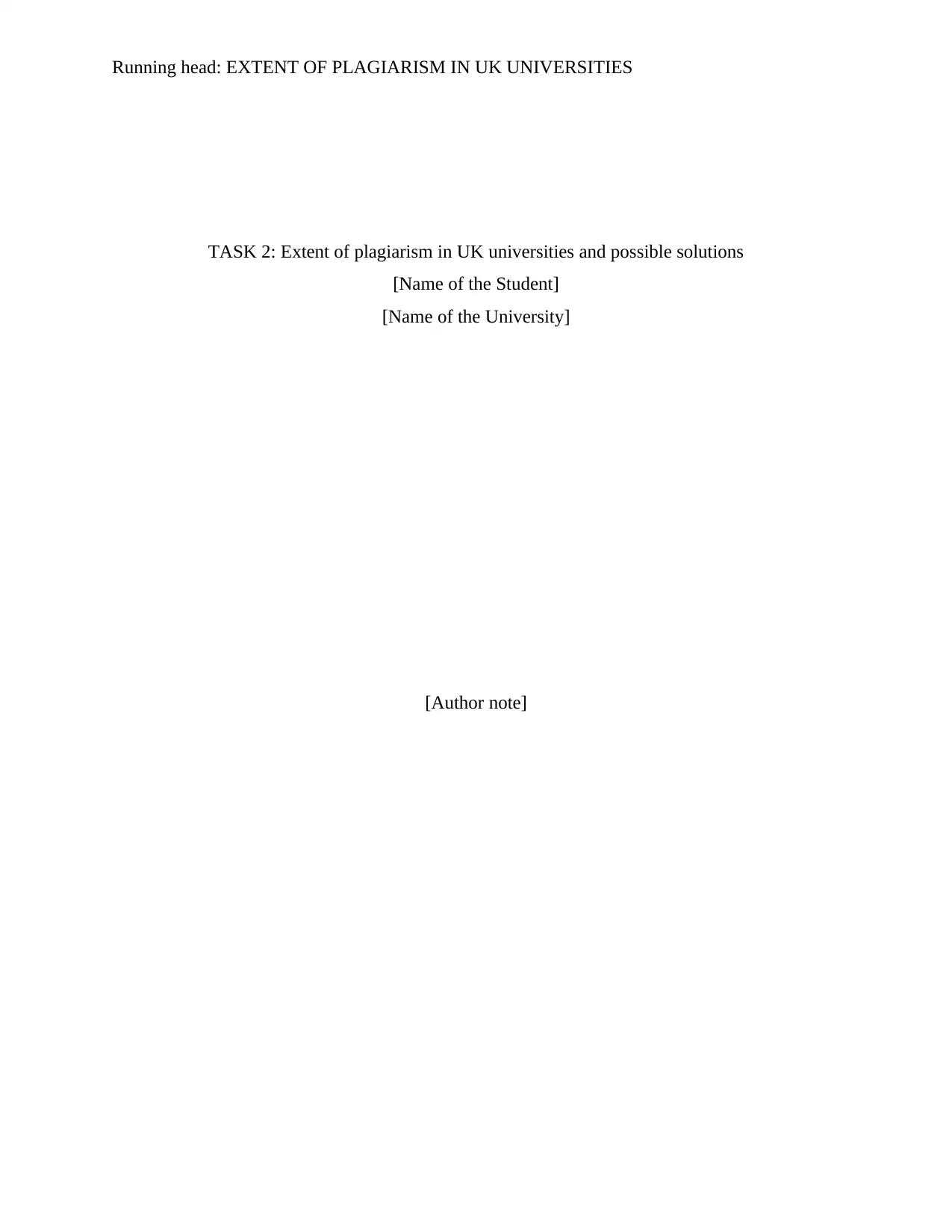
Running head: EXTENT OF PLAGIARISM IN UK UNIVERSITIES
TASK 2: Extent of plagiarism in UK universities and possible solutions
[Name of the Student]
[Name of the University]
[Author note]
TASK 2: Extent of plagiarism in UK universities and possible solutions
[Name of the Student]
[Name of the University]
[Author note]
Paraphrase This Document
Need a fresh take? Get an instant paraphrase of this document with our AI Paraphraser
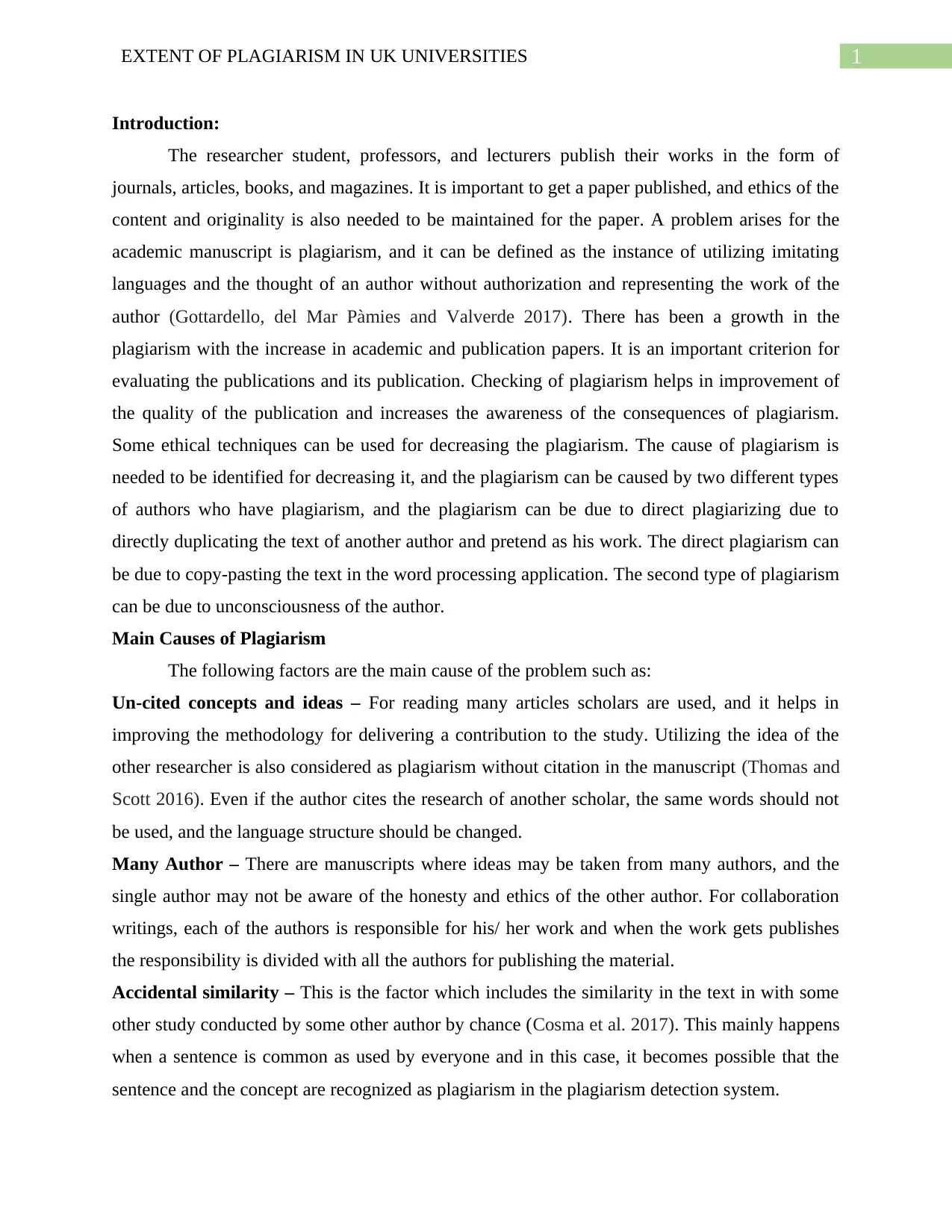
1EXTENT OF PLAGIARISM IN UK UNIVERSITIES
Introduction:
The researcher student, professors, and lecturers publish their works in the form of
journals, articles, books, and magazines. It is important to get a paper published, and ethics of the
content and originality is also needed to be maintained for the paper. A problem arises for the
academic manuscript is plagiarism, and it can be defined as the instance of utilizing imitating
languages and the thought of an author without authorization and representing the work of the
author (Gottardello, del Mar Pàmies and Valverde 2017). There has been a growth in the
plagiarism with the increase in academic and publication papers. It is an important criterion for
evaluating the publications and its publication. Checking of plagiarism helps in improvement of
the quality of the publication and increases the awareness of the consequences of plagiarism.
Some ethical techniques can be used for decreasing the plagiarism. The cause of plagiarism is
needed to be identified for decreasing it, and the plagiarism can be caused by two different types
of authors who have plagiarism, and the plagiarism can be due to direct plagiarizing due to
directly duplicating the text of another author and pretend as his work. The direct plagiarism can
be due to copy-pasting the text in the word processing application. The second type of plagiarism
can be due to unconsciousness of the author.
Main Causes of Plagiarism
The following factors are the main cause of the problem such as:
Un-cited concepts and ideas – For reading many articles scholars are used, and it helps in
improving the methodology for delivering a contribution to the study. Utilizing the idea of the
other researcher is also considered as plagiarism without citation in the manuscript (Thomas and
Scott 2016). Even if the author cites the research of another scholar, the same words should not
be used, and the language structure should be changed.
Many Author – There are manuscripts where ideas may be taken from many authors, and the
single author may not be aware of the honesty and ethics of the other author. For collaboration
writings, each of the authors is responsible for his/ her work and when the work gets publishes
the responsibility is divided with all the authors for publishing the material.
Accidental similarity – This is the factor which includes the similarity in the text in with some
other study conducted by some other author by chance (Cosma et al. 2017). This mainly happens
when a sentence is common as used by everyone and in this case, it becomes possible that the
sentence and the concept are recognized as plagiarism in the plagiarism detection system.
Introduction:
The researcher student, professors, and lecturers publish their works in the form of
journals, articles, books, and magazines. It is important to get a paper published, and ethics of the
content and originality is also needed to be maintained for the paper. A problem arises for the
academic manuscript is plagiarism, and it can be defined as the instance of utilizing imitating
languages and the thought of an author without authorization and representing the work of the
author (Gottardello, del Mar Pàmies and Valverde 2017). There has been a growth in the
plagiarism with the increase in academic and publication papers. It is an important criterion for
evaluating the publications and its publication. Checking of plagiarism helps in improvement of
the quality of the publication and increases the awareness of the consequences of plagiarism.
Some ethical techniques can be used for decreasing the plagiarism. The cause of plagiarism is
needed to be identified for decreasing it, and the plagiarism can be caused by two different types
of authors who have plagiarism, and the plagiarism can be due to direct plagiarizing due to
directly duplicating the text of another author and pretend as his work. The direct plagiarism can
be due to copy-pasting the text in the word processing application. The second type of plagiarism
can be due to unconsciousness of the author.
Main Causes of Plagiarism
The following factors are the main cause of the problem such as:
Un-cited concepts and ideas – For reading many articles scholars are used, and it helps in
improving the methodology for delivering a contribution to the study. Utilizing the idea of the
other researcher is also considered as plagiarism without citation in the manuscript (Thomas and
Scott 2016). Even if the author cites the research of another scholar, the same words should not
be used, and the language structure should be changed.
Many Author – There are manuscripts where ideas may be taken from many authors, and the
single author may not be aware of the honesty and ethics of the other author. For collaboration
writings, each of the authors is responsible for his/ her work and when the work gets publishes
the responsibility is divided with all the authors for publishing the material.
Accidental similarity – This is the factor which includes the similarity in the text in with some
other study conducted by some other author by chance (Cosma et al. 2017). This mainly happens
when a sentence is common as used by everyone and in this case, it becomes possible that the
sentence and the concept are recognized as plagiarism in the plagiarism detection system.
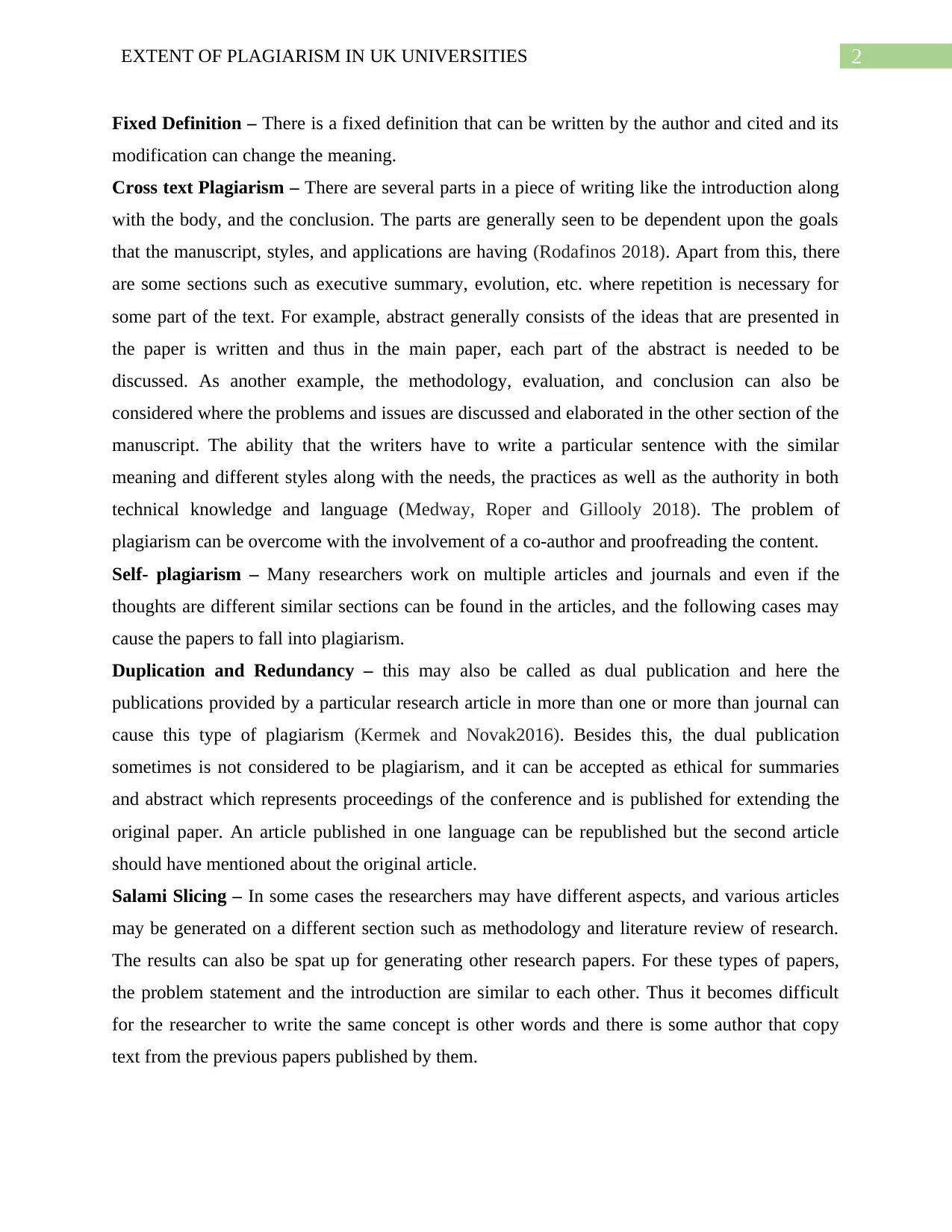
2EXTENT OF PLAGIARISM IN UK UNIVERSITIES
Fixed Definition – There is a fixed definition that can be written by the author and cited and its
modification can change the meaning.
Cross text Plagiarism – There are several parts in a piece of writing like the introduction along
with the body, and the conclusion. The parts are generally seen to be dependent upon the goals
that the manuscript, styles, and applications are having (Rodafinos 2018). Apart from this, there
are some sections such as executive summary, evolution, etc. where repetition is necessary for
some part of the text. For example, abstract generally consists of the ideas that are presented in
the paper is written and thus in the main paper, each part of the abstract is needed to be
discussed. As another example, the methodology, evaluation, and conclusion can also be
considered where the problems and issues are discussed and elaborated in the other section of the
manuscript. The ability that the writers have to write a particular sentence with the similar
meaning and different styles along with the needs, the practices as well as the authority in both
technical knowledge and language (Medway, Roper and Gillooly 2018). The problem of
plagiarism can be overcome with the involvement of a co-author and proofreading the content.
Self- plagiarism – Many researchers work on multiple articles and journals and even if the
thoughts are different similar sections can be found in the articles, and the following cases may
cause the papers to fall into plagiarism.
Duplication and Redundancy – this may also be called as dual publication and here the
publications provided by a particular research article in more than one or more than journal can
cause this type of plagiarism (Kermek and Novak2016). Besides this, the dual publication
sometimes is not considered to be plagiarism, and it can be accepted as ethical for summaries
and abstract which represents proceedings of the conference and is published for extending the
original paper. An article published in one language can be republished but the second article
should have mentioned about the original article.
Salami Slicing – In some cases the researchers may have different aspects, and various articles
may be generated on a different section such as methodology and literature review of research.
The results can also be spat up for generating other research papers. For these types of papers,
the problem statement and the introduction are similar to each other. Thus it becomes difficult
for the researcher to write the same concept is other words and there is some author that copy
text from the previous papers published by them.
Fixed Definition – There is a fixed definition that can be written by the author and cited and its
modification can change the meaning.
Cross text Plagiarism – There are several parts in a piece of writing like the introduction along
with the body, and the conclusion. The parts are generally seen to be dependent upon the goals
that the manuscript, styles, and applications are having (Rodafinos 2018). Apart from this, there
are some sections such as executive summary, evolution, etc. where repetition is necessary for
some part of the text. For example, abstract generally consists of the ideas that are presented in
the paper is written and thus in the main paper, each part of the abstract is needed to be
discussed. As another example, the methodology, evaluation, and conclusion can also be
considered where the problems and issues are discussed and elaborated in the other section of the
manuscript. The ability that the writers have to write a particular sentence with the similar
meaning and different styles along with the needs, the practices as well as the authority in both
technical knowledge and language (Medway, Roper and Gillooly 2018). The problem of
plagiarism can be overcome with the involvement of a co-author and proofreading the content.
Self- plagiarism – Many researchers work on multiple articles and journals and even if the
thoughts are different similar sections can be found in the articles, and the following cases may
cause the papers to fall into plagiarism.
Duplication and Redundancy – this may also be called as dual publication and here the
publications provided by a particular research article in more than one or more than journal can
cause this type of plagiarism (Kermek and Novak2016). Besides this, the dual publication
sometimes is not considered to be plagiarism, and it can be accepted as ethical for summaries
and abstract which represents proceedings of the conference and is published for extending the
original paper. An article published in one language can be republished but the second article
should have mentioned about the original article.
Salami Slicing – In some cases the researchers may have different aspects, and various articles
may be generated on a different section such as methodology and literature review of research.
The results can also be spat up for generating other research papers. For these types of papers,
the problem statement and the introduction are similar to each other. Thus it becomes difficult
for the researcher to write the same concept is other words and there is some author that copy
text from the previous papers published by them.
⊘ This is a preview!⊘
Do you want full access?
Subscribe today to unlock all pages.

Trusted by 1+ million students worldwide
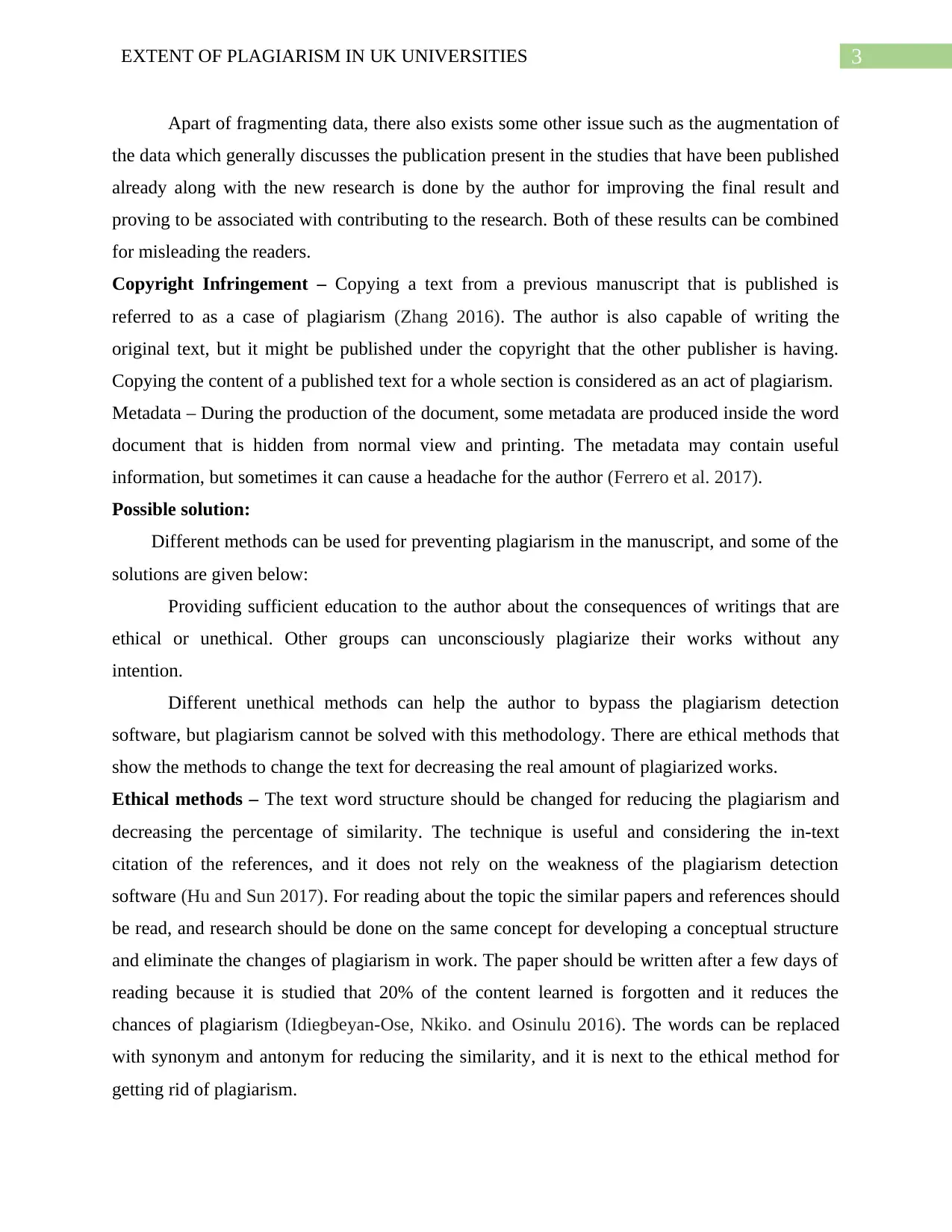
3EXTENT OF PLAGIARISM IN UK UNIVERSITIES
Apart of fragmenting data, there also exists some other issue such as the augmentation of
the data which generally discusses the publication present in the studies that have been published
already along with the new research is done by the author for improving the final result and
proving to be associated with contributing to the research. Both of these results can be combined
for misleading the readers.
Copyright Infringement – Copying a text from a previous manuscript that is published is
referred to as a case of plagiarism (Zhang 2016). The author is also capable of writing the
original text, but it might be published under the copyright that the other publisher is having.
Copying the content of a published text for a whole section is considered as an act of plagiarism.
Metadata – During the production of the document, some metadata are produced inside the word
document that is hidden from normal view and printing. The metadata may contain useful
information, but sometimes it can cause a headache for the author (Ferrero et al. 2017).
Possible solution:
Different methods can be used for preventing plagiarism in the manuscript, and some of the
solutions are given below:
Providing sufficient education to the author about the consequences of writings that are
ethical or unethical. Other groups can unconsciously plagiarize their works without any
intention.
Different unethical methods can help the author to bypass the plagiarism detection
software, but plagiarism cannot be solved with this methodology. There are ethical methods that
show the methods to change the text for decreasing the real amount of plagiarized works.
Ethical methods – The text word structure should be changed for reducing the plagiarism and
decreasing the percentage of similarity. The technique is useful and considering the in-text
citation of the references, and it does not rely on the weakness of the plagiarism detection
software (Hu and Sun 2017). For reading about the topic the similar papers and references should
be read, and research should be done on the same concept for developing a conceptual structure
and eliminate the changes of plagiarism in work. The paper should be written after a few days of
reading because it is studied that 20% of the content learned is forgotten and it reduces the
chances of plagiarism (Idiegbeyan-Ose, Nkiko. and Osinulu 2016). The words can be replaced
with synonym and antonym for reducing the similarity, and it is next to the ethical method for
getting rid of plagiarism.
Apart of fragmenting data, there also exists some other issue such as the augmentation of
the data which generally discusses the publication present in the studies that have been published
already along with the new research is done by the author for improving the final result and
proving to be associated with contributing to the research. Both of these results can be combined
for misleading the readers.
Copyright Infringement – Copying a text from a previous manuscript that is published is
referred to as a case of plagiarism (Zhang 2016). The author is also capable of writing the
original text, but it might be published under the copyright that the other publisher is having.
Copying the content of a published text for a whole section is considered as an act of plagiarism.
Metadata – During the production of the document, some metadata are produced inside the word
document that is hidden from normal view and printing. The metadata may contain useful
information, but sometimes it can cause a headache for the author (Ferrero et al. 2017).
Possible solution:
Different methods can be used for preventing plagiarism in the manuscript, and some of the
solutions are given below:
Providing sufficient education to the author about the consequences of writings that are
ethical or unethical. Other groups can unconsciously plagiarize their works without any
intention.
Different unethical methods can help the author to bypass the plagiarism detection
software, but plagiarism cannot be solved with this methodology. There are ethical methods that
show the methods to change the text for decreasing the real amount of plagiarized works.
Ethical methods – The text word structure should be changed for reducing the plagiarism and
decreasing the percentage of similarity. The technique is useful and considering the in-text
citation of the references, and it does not rely on the weakness of the plagiarism detection
software (Hu and Sun 2017). For reading about the topic the similar papers and references should
be read, and research should be done on the same concept for developing a conceptual structure
and eliminate the changes of plagiarism in work. The paper should be written after a few days of
reading because it is studied that 20% of the content learned is forgotten and it reduces the
chances of plagiarism (Idiegbeyan-Ose, Nkiko. and Osinulu 2016). The words can be replaced
with synonym and antonym for reducing the similarity, and it is next to the ethical method for
getting rid of plagiarism.
Paraphrase This Document
Need a fresh take? Get an instant paraphrase of this document with our AI Paraphraser
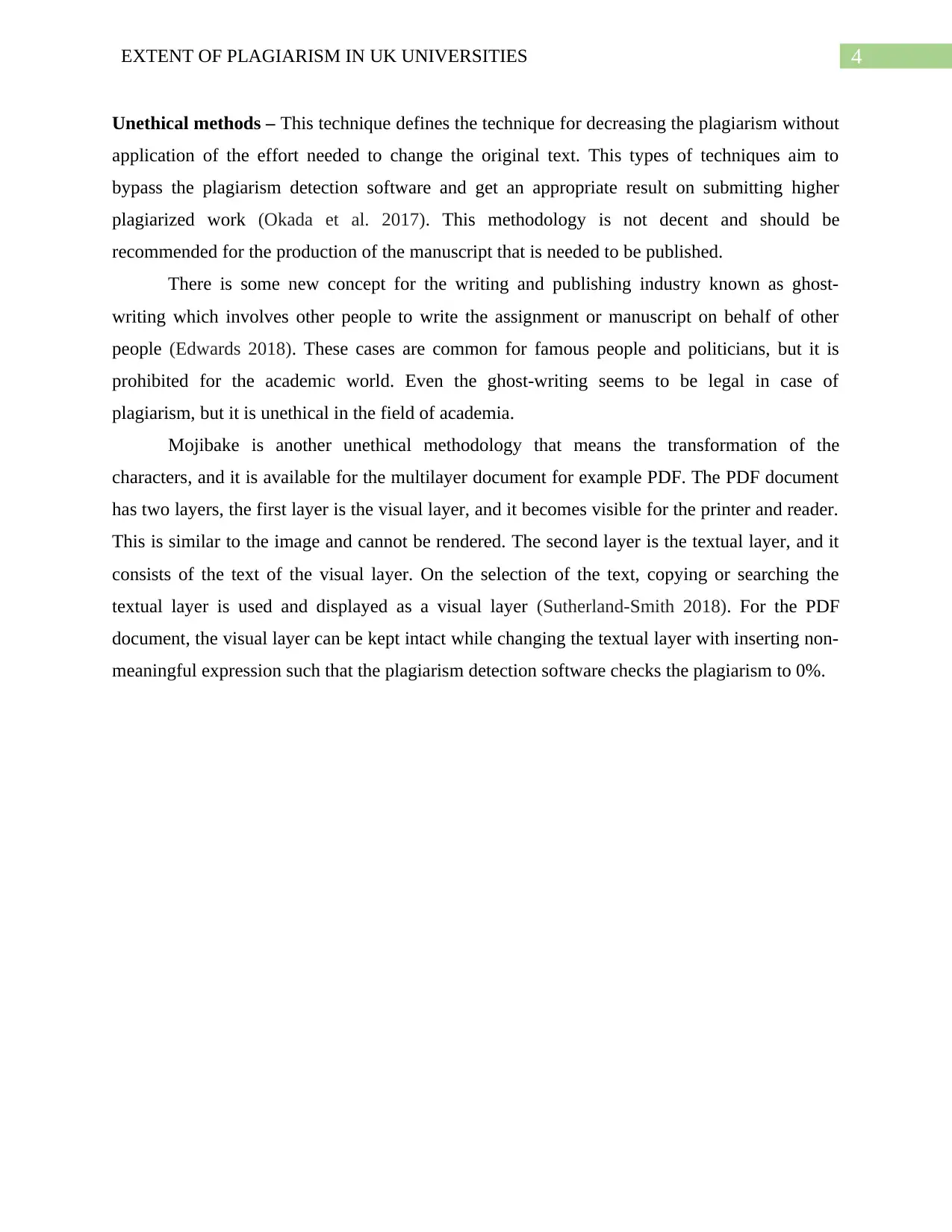
4EXTENT OF PLAGIARISM IN UK UNIVERSITIES
Unethical methods – This technique defines the technique for decreasing the plagiarism without
application of the effort needed to change the original text. This types of techniques aim to
bypass the plagiarism detection software and get an appropriate result on submitting higher
plagiarized work (Okada et al. 2017). This methodology is not decent and should be
recommended for the production of the manuscript that is needed to be published.
There is some new concept for the writing and publishing industry known as ghost-
writing which involves other people to write the assignment or manuscript on behalf of other
people (Edwards 2018). These cases are common for famous people and politicians, but it is
prohibited for the academic world. Even the ghost-writing seems to be legal in case of
plagiarism, but it is unethical in the field of academia.
Mojibake is another unethical methodology that means the transformation of the
characters, and it is available for the multilayer document for example PDF. The PDF document
has two layers, the first layer is the visual layer, and it becomes visible for the printer and reader.
This is similar to the image and cannot be rendered. The second layer is the textual layer, and it
consists of the text of the visual layer. On the selection of the text, copying or searching the
textual layer is used and displayed as a visual layer (Sutherland-Smith 2018). For the PDF
document, the visual layer can be kept intact while changing the textual layer with inserting non-
meaningful expression such that the plagiarism detection software checks the plagiarism to 0%.
Unethical methods – This technique defines the technique for decreasing the plagiarism without
application of the effort needed to change the original text. This types of techniques aim to
bypass the plagiarism detection software and get an appropriate result on submitting higher
plagiarized work (Okada et al. 2017). This methodology is not decent and should be
recommended for the production of the manuscript that is needed to be published.
There is some new concept for the writing and publishing industry known as ghost-
writing which involves other people to write the assignment or manuscript on behalf of other
people (Edwards 2018). These cases are common for famous people and politicians, but it is
prohibited for the academic world. Even the ghost-writing seems to be legal in case of
plagiarism, but it is unethical in the field of academia.
Mojibake is another unethical methodology that means the transformation of the
characters, and it is available for the multilayer document for example PDF. The PDF document
has two layers, the first layer is the visual layer, and it becomes visible for the printer and reader.
This is similar to the image and cannot be rendered. The second layer is the textual layer, and it
consists of the text of the visual layer. On the selection of the text, copying or searching the
textual layer is used and displayed as a visual layer (Sutherland-Smith 2018). For the PDF
document, the visual layer can be kept intact while changing the textual layer with inserting non-
meaningful expression such that the plagiarism detection software checks the plagiarism to 0%.
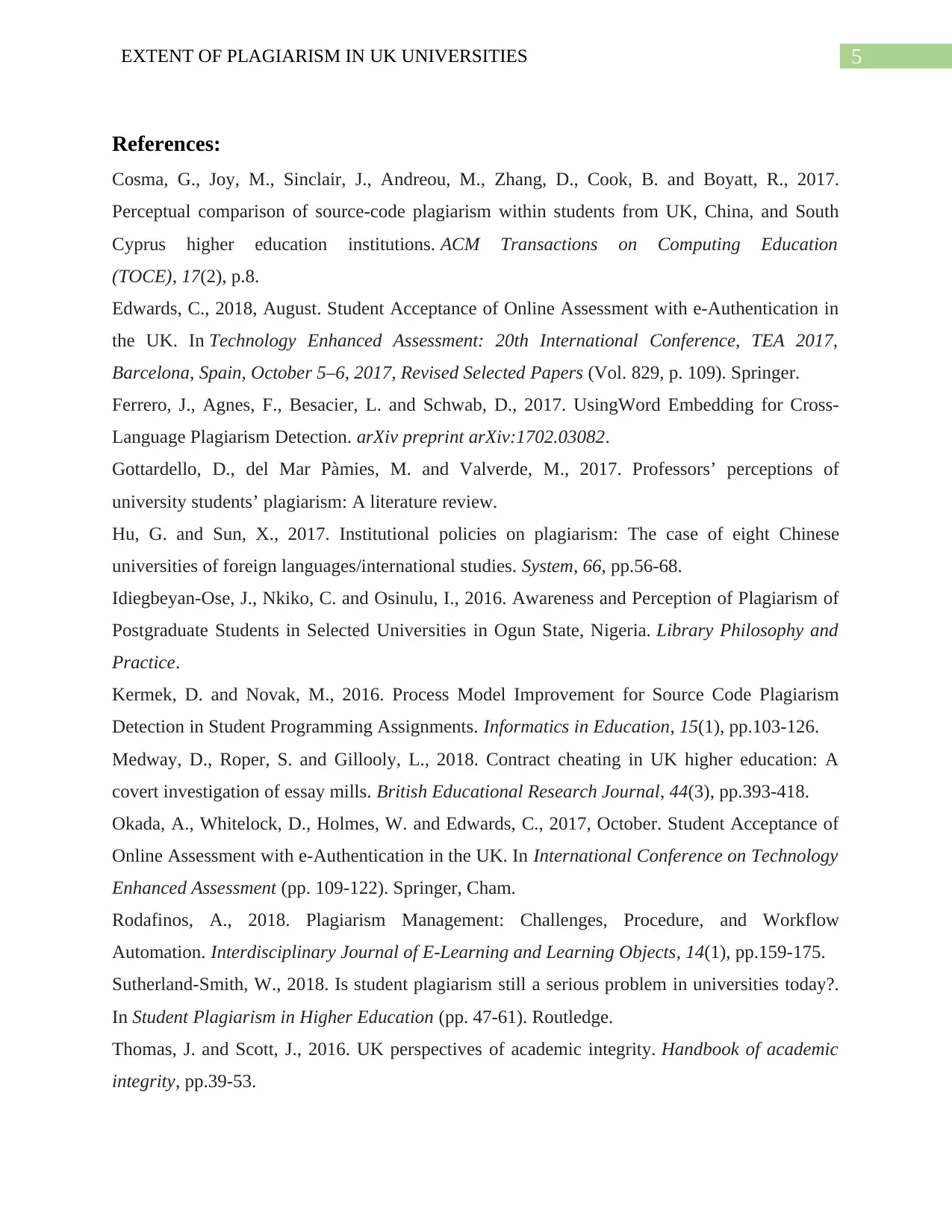
5EXTENT OF PLAGIARISM IN UK UNIVERSITIES
References:
Cosma, G., Joy, M., Sinclair, J., Andreou, M., Zhang, D., Cook, B. and Boyatt, R., 2017.
Perceptual comparison of source-code plagiarism within students from UK, China, and South
Cyprus higher education institutions. ACM Transactions on Computing Education
(TOCE), 17(2), p.8.
Edwards, C., 2018, August. Student Acceptance of Online Assessment with e-Authentication in
the UK. In Technology Enhanced Assessment: 20th International Conference, TEA 2017,
Barcelona, Spain, October 5–6, 2017, Revised Selected Papers (Vol. 829, p. 109). Springer.
Ferrero, J., Agnes, F., Besacier, L. and Schwab, D., 2017. UsingWord Embedding for Cross-
Language Plagiarism Detection. arXiv preprint arXiv:1702.03082.
Gottardello, D., del Mar Pàmies, M. and Valverde, M., 2017. Professors’ perceptions of
university students’ plagiarism: A literature review.
Hu, G. and Sun, X., 2017. Institutional policies on plagiarism: The case of eight Chinese
universities of foreign languages/international studies. System, 66, pp.56-68.
Idiegbeyan-Ose, J., Nkiko, C. and Osinulu, I., 2016. Awareness and Perception of Plagiarism of
Postgraduate Students in Selected Universities in Ogun State, Nigeria. Library Philosophy and
Practice.
Kermek, D. and Novak, M., 2016. Process Model Improvement for Source Code Plagiarism
Detection in Student Programming Assignments. Informatics in Education, 15(1), pp.103-126.
Medway, D., Roper, S. and Gillooly, L., 2018. Contract cheating in UK higher education: A
covert investigation of essay mills. British Educational Research Journal, 44(3), pp.393-418.
Okada, A., Whitelock, D., Holmes, W. and Edwards, C., 2017, October. Student Acceptance of
Online Assessment with e-Authentication in the UK. In International Conference on Technology
Enhanced Assessment (pp. 109-122). Springer, Cham.
Rodafinos, A., 2018. Plagiarism Management: Challenges, Procedure, and Workflow
Automation. Interdisciplinary Journal of E-Learning and Learning Objects, 14(1), pp.159-175.
Sutherland-Smith, W., 2018. Is student plagiarism still a serious problem in universities today?.
In Student Plagiarism in Higher Education (pp. 47-61). Routledge.
Thomas, J. and Scott, J., 2016. UK perspectives of academic integrity. Handbook of academic
integrity, pp.39-53.
References:
Cosma, G., Joy, M., Sinclair, J., Andreou, M., Zhang, D., Cook, B. and Boyatt, R., 2017.
Perceptual comparison of source-code plagiarism within students from UK, China, and South
Cyprus higher education institutions. ACM Transactions on Computing Education
(TOCE), 17(2), p.8.
Edwards, C., 2018, August. Student Acceptance of Online Assessment with e-Authentication in
the UK. In Technology Enhanced Assessment: 20th International Conference, TEA 2017,
Barcelona, Spain, October 5–6, 2017, Revised Selected Papers (Vol. 829, p. 109). Springer.
Ferrero, J., Agnes, F., Besacier, L. and Schwab, D., 2017. UsingWord Embedding for Cross-
Language Plagiarism Detection. arXiv preprint arXiv:1702.03082.
Gottardello, D., del Mar Pàmies, M. and Valverde, M., 2017. Professors’ perceptions of
university students’ plagiarism: A literature review.
Hu, G. and Sun, X., 2017. Institutional policies on plagiarism: The case of eight Chinese
universities of foreign languages/international studies. System, 66, pp.56-68.
Idiegbeyan-Ose, J., Nkiko, C. and Osinulu, I., 2016. Awareness and Perception of Plagiarism of
Postgraduate Students in Selected Universities in Ogun State, Nigeria. Library Philosophy and
Practice.
Kermek, D. and Novak, M., 2016. Process Model Improvement for Source Code Plagiarism
Detection in Student Programming Assignments. Informatics in Education, 15(1), pp.103-126.
Medway, D., Roper, S. and Gillooly, L., 2018. Contract cheating in UK higher education: A
covert investigation of essay mills. British Educational Research Journal, 44(3), pp.393-418.
Okada, A., Whitelock, D., Holmes, W. and Edwards, C., 2017, October. Student Acceptance of
Online Assessment with e-Authentication in the UK. In International Conference on Technology
Enhanced Assessment (pp. 109-122). Springer, Cham.
Rodafinos, A., 2018. Plagiarism Management: Challenges, Procedure, and Workflow
Automation. Interdisciplinary Journal of E-Learning and Learning Objects, 14(1), pp.159-175.
Sutherland-Smith, W., 2018. Is student plagiarism still a serious problem in universities today?.
In Student Plagiarism in Higher Education (pp. 47-61). Routledge.
Thomas, J. and Scott, J., 2016. UK perspectives of academic integrity. Handbook of academic
integrity, pp.39-53.
⊘ This is a preview!⊘
Do you want full access?
Subscribe today to unlock all pages.

Trusted by 1+ million students worldwide
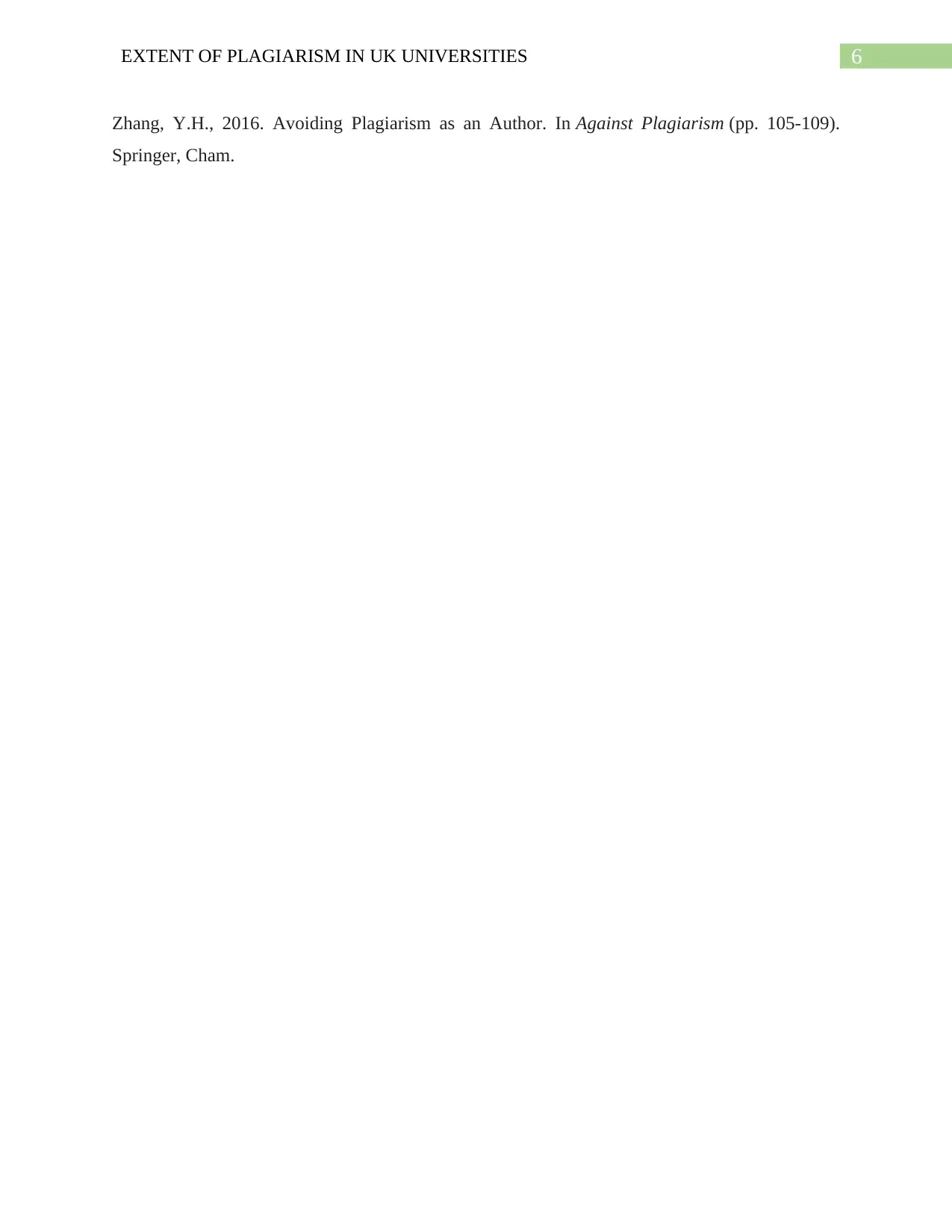
6EXTENT OF PLAGIARISM IN UK UNIVERSITIES
Zhang, Y.H., 2016. Avoiding Plagiarism as an Author. In Against Plagiarism (pp. 105-109).
Springer, Cham.
Zhang, Y.H., 2016. Avoiding Plagiarism as an Author. In Against Plagiarism (pp. 105-109).
Springer, Cham.
1 out of 7
Related Documents
Your All-in-One AI-Powered Toolkit for Academic Success.
+13062052269
info@desklib.com
Available 24*7 on WhatsApp / Email
![[object Object]](/_next/static/media/star-bottom.7253800d.svg)
Unlock your academic potential
Copyright © 2020–2025 A2Z Services. All Rights Reserved. Developed and managed by ZUCOL.





